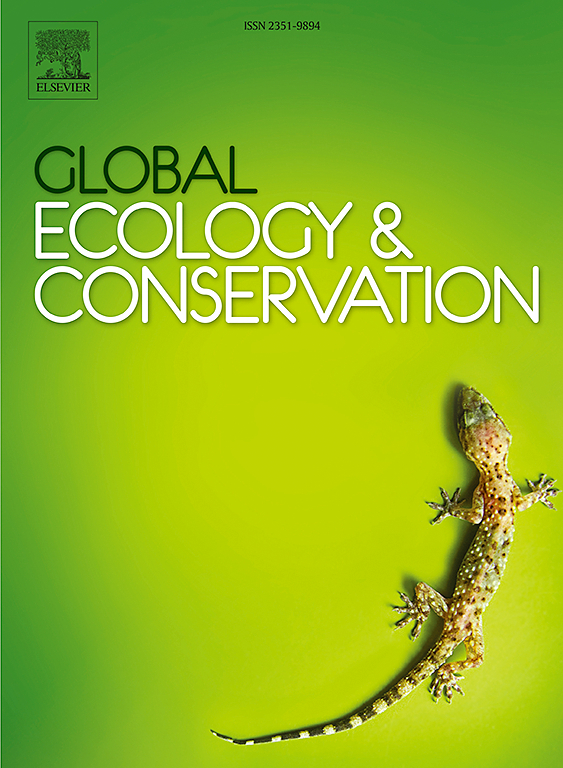当地生境和景观属性对哥伦比亚安第斯山脉遮荫咖啡种植园鸟类群落的影响
IF 3.5
2区 环境科学与生态学
Q1 BIODIVERSITY CONSERVATION
引用次数: 0
摘要
农林业通过增加农业景观中的树木覆盖率来支持生物多样性保护的做法越来越多地得到推广,但景观环境在多大程度上影响效益的累积仍不确定。在哥伦比亚两个森林覆盖率不同的省份,160 个咖啡种植园的咖啡植株密度和荫生树的丰富度和丰度各不相同,我们利用荫生咖啡系统研究了景观中森林和森林-农业镶嵌的邻近程度和范围如何影响这些咖啡种植园中的鸟类群落。我们的研究结果表明,地区森林覆盖率和景观条件会影响鸟类对种植园当地栖息地的反应。只有在森林覆盖率相对较高的安蒂奥基亚省(平均 32% 的区域森林覆盖率),鸟类的丰富度和群落完整性与咖啡种植园周围景观中的森林-农业镶嵌数量呈正相关,尤其是在种植园树木丰富度和丰度较高的地方。在大部分森林被砍伐的考卡省(平均森林覆盖率为 1%),无论是森林距离还是森林-农业复合体覆盖率都无法解释鸟类的丰富度和群落完整性,两者都只与当地树木的丰富度和丰度呈正相关。我们的研究结果表明,生物多样性受益于当地和景观尺度上栖息地质量的提高,随着更广阔景观中栖息地数量的减少,种植园内栖息地质量的影响也越来越大。我们的研究结果强调了景观环境在保护规划中的作用,以促进咖啡种植区的生物多样性。本文章由计算机程序翻译,如有差异,请以英文原文为准。
Effect of local habitat and landscape attributes on bird communities in shade coffee plantations in the Colombian Andes
Agroforestry is increasingly promoted to support biodiversity conservation by increasing tree cover in agricultural landscapes, but the extent to which landscape context affects how benefits accrue remains uncertain. We used shade-coffee systems to ask how the proximity and extent of forest and forest-agriculture mosaic in the landscape influenced bird communities in 160 coffee plantations that differed in coffee plant density and shade tree richness and abundance in two departments of Colombia with differing regional forest cover. Our findings suggest that regional forest cover and landscape conditions can mediate the response of birds to local habitats on plantations. Avian richness and community completeness was positively related to the amount of forest-agriculture mosaic within landscapes surrounding coffee plantations only within the comparatively forested department of Antioquia (mean 32 % regional forest cover), particularly where plantations had high richness and abundance of trees. In the largely deforested department of Cauca (mean 1 %), neither distance to forest nor cover by forest-agriculture mosaics explained avian richness and community completeness, both of which were positively related only to local tree richness and abundance. We show that biodiversity benefits from increasing habitat quality at local and landscape scales, and habitat quality within plantations becomes increasingly influential as the amount of habitat in the broader landscape declines. Our results emphasize the role of landscape context in conservation planning to promote biodiversity in coffee-growing regions.
求助全文
通过发布文献求助,成功后即可免费获取论文全文。
去求助
来源期刊

Global Ecology and Conservation
Agricultural and Biological Sciences-Ecology, Evolution, Behavior and Systematics
CiteScore
8.10
自引率
5.00%
发文量
346
审稿时长
83 days
期刊介绍:
Global Ecology and Conservation is a peer-reviewed, open-access journal covering all sub-disciplines of ecological and conservation science: from theory to practice, from molecules to ecosystems, from regional to global. The fields covered include: organismal, population, community, and ecosystem ecology; physiological, evolutionary, and behavioral ecology; and conservation science.
 求助内容:
求助内容: 应助结果提醒方式:
应助结果提醒方式:


